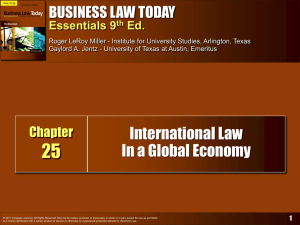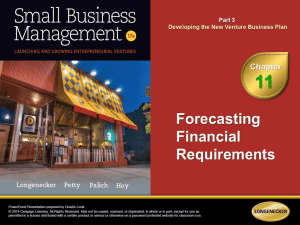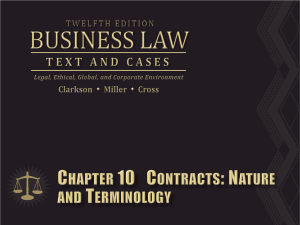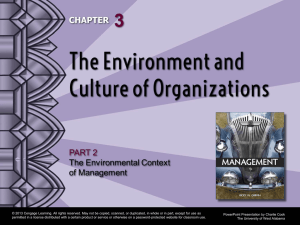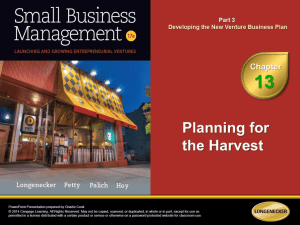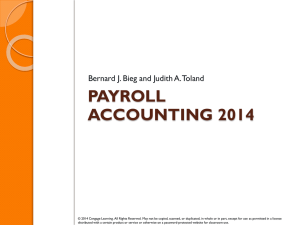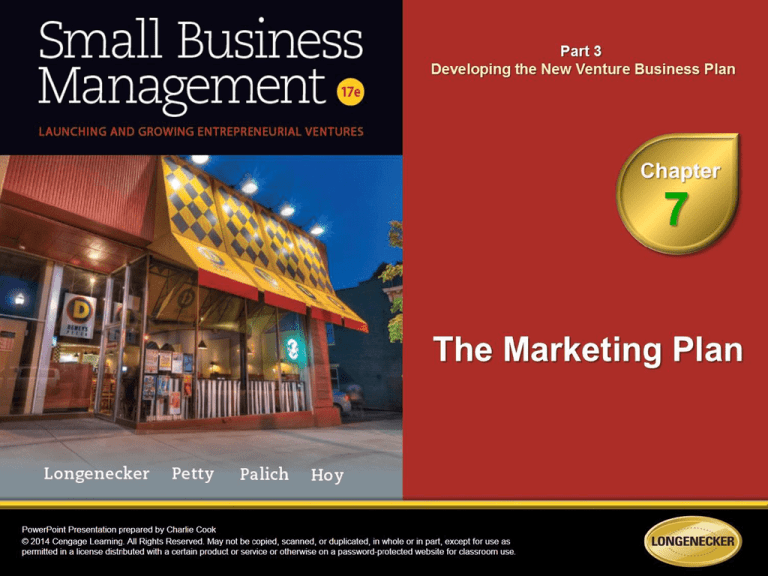
1. Describe small business marketing.
2. Identify the components of a formal marketing plan.
3. Discuss the nature of the marketing research process.
4. Define market segmentation, and discuss its related
strategies.
5. Explain the different methods of forecasting sales.
© 2014 Cengage Learning. All Rights Reserved. May not be copied, scanned, or duplicated, in whole or in part, except for use as
permitted in a license distributed with a certain product or service or otherwise on a password-protected website for classroom use.
7–2
What is Small Business Marketing?
• Small Business Marketing
Business activities that direct the creation,
development, and delivery of a bundle of
satisfaction from the creator to the targeted user.
• Small Business Marketing Activities
Identification of the target market
Determining target market’s potential
Preparing, communicating, and delivering a bundle
of satisfaction to the target market
© 2014 Cengage Learning. All Rights Reserved. May not be copied, scanned, or duplicated, in whole or in part, except for use as
permitted in a license distributed with a certain product or service or otherwise on a password-protected website for classroom use.
7–3
Three Levels of a Product and/or Service
Basic product/service plus
extra or unsolicited benefits
to the consumer
Fundamental benefit
or solution sought by
customers.
Basic physical
product/service that
delivers the benefits.
© 2014 Cengage Learning. All Rights Reserved. May not be copied, scanned, or duplicated, in whole or in part, except for use as
permitted in a license distributed with a certain product or service or otherwise on a password-protected website for classroom use.
7–4
Marketing Philosophies Make a Difference
• Production-Oriented
Emphasizes development of the product and
production efficiencies over other activities.
• Sales-Oriented
Favors product sales over production efficiencies and
customer preferences.
• Consumer Oriented—The Right Choice
All marketing efforts begin and end with customers.
The focus is on consumers’ needs, which is most
consistent with long-term success of the firm.
© 2014 Cengage Learning. All Rights Reserved. May not be copied, scanned, or duplicated, in whole or in part, except for use as
permitted in a license distributed with a certain product or service or otherwise on a password-protected website for classroom use.
7–5
Consumer Orientation—The Right Choice
• Reasons for Not Adopting
a Consumer Orientation
State of competition
With no competition or high demand, firms focus
on production.
Production focus
Entrepreneurs may have strong production skills
and weak marketing skills.
Focus on the present
Entrepreneurs tend to focus on current success
which is the result of an overemphasis on selling.
© 2014 Cengage Learning. All Rights Reserved. May not be copied, scanned, or duplicated, in whole or in part, except for use as
permitted in a license distributed with a certain product or service or otherwise on a password-protected website for classroom use.
7–6
7.1
The Marketing Plan and Supporting Marketing Activities
© 2014 Cengage Learning. All Rights Reserved. May not be copied, scanned, or duplicated, in whole or in part, except for use as
permitted in a license distributed with a certain product or service or otherwise on a password-protected website for classroom use.
7–7
Marketing Research Activities
• Market Analysis
An evaluation process that encompasses
market segmentation, marketing research,
and sales forecasting
• Developing the Marketing Mix
The combination of product,
pricing, promotion, and
distribution activities.
© 2014 Cengage Learning. All Rights Reserved. May not be copied, scanned, or duplicated, in whole or in part, except for use as
permitted in a license distributed with a certain product or service or otherwise on a password-protected website for classroom use.
7–8
The Formal Marketing Plan
• Market Analysis
Customer profile
A description of potential customers in a target market
Sales forecasts
“Most likely,” “pessimistic,” and “optimistic
• The Competition
Profile of key management personnel
Overall strengths and weaknesses (SWOT)
Related products being marketed or tested
Likelihood of competitors’ entry into target market
© 2014 Cengage Learning. All Rights Reserved. May not be copied, scanned, or duplicated, in whole or in part, except for use as
permitted in a license distributed with a certain product or service or otherwise on a password-protected website for classroom use.
7–9
The Formal Marketing Plan (cont’d)
• Marketing Strategy
Product and/or service section
Decisions affecting the total product
Distribution section
Decisions regarding product delivery to customers
Pricing section
Setting an acceptable value on the product
Promotional section
Communicating information to the target market
© 2014 Cengage Learning. All Rights Reserved. May not be copied, scanned, or duplicated, in whole or in part, except for use as
permitted in a license distributed with a certain product or service or otherwise on a password-protected website for classroom use.
7–10
The Nature of Marketing Research
• Marketing Research
The gathering, processing, reporting, and
interpreting of market information
• Outside Sources
Hiring professional marketing researchers
Using the Internet for
web-based surveys
and online focus groups
© 2014 Cengage Learning. All Rights Reserved. May not be copied, scanned, or duplicated, in whole or in part, except for use as
permitted in a license distributed with a certain product or service or otherwise on a password-protected website for classroom use.
7–11
The Nature of Marketing Research
• Steps In the Marketing Research Process
1. Identifying the informational need
Why do we need to know this?
2. Searching for secondary data
Who has researched this topic already?
3. Collecting primary data
Who do we ask and what do we ask them?
4. Interpreting the data
Got the information, now what does it mean?
© 2014 Cengage Learning. All Rights Reserved. May not be copied, scanned, or duplicated, in whole or in part, except for use as
permitted in a license distributed with a certain product or service or otherwise on a password-protected website for classroom use.
7–12
Methods for Collecting Primary Data
• Observational
Methods
Human
Mechanical
• Questioning Methods
Surveys
Mail
Telephone
Personal interviews
Experiments
© 2014 Cengage Learning. All Rights Reserved. May not be copied, scanned, or duplicated, in whole or in part, except for use as
permitted in a license distributed with a certain product or service or otherwise on a password-protected website for classroom use.
7–13
Designing and Testing a Questionnaire
• Ask questions that relate to the issue.
• Use open-ended and multiple-choice questions.
• Carefully consider the order of the questions to avoid
producing biased answers to later questions.
• Ask sensitive questions near the end of the
questionnaire.
• Word questions as simply, clearly,
and objectively as possible.
• Pre-test the questionnaire on a
small representative sample
of respondents.
© 2014 Cengage Learning. All Rights Reserved. May not be copied, scanned, or duplicated, in whole or in part, except for use as
permitted in a license distributed with a certain product or service or otherwise on a password-protected website for classroom use.
7–14
Interpreting the Data Gathered
• Transforming Data into Information
Tables and charts
Descriptive statistics
• When Research is Too Expensive
Newspaper, magazine, and industry trade
journal articles and trade research
Internet searches
Check out the competition
Use students to stretch research budget
Trust your hands-on feel for the market
© 2014 Cengage Learning. All Rights Reserved. May not be copied, scanned, or duplicated, in whole or in part, except for use as
permitted in a license distributed with a certain product or service or otherwise on a password-protected website for classroom use.
7–15
When Not To Conduct Formal Research
• Your firm doesn’t have the resources to conduct research properly
or to implement findings generated from the proposed research.
• The opportunity for a new business or product introduction has
passed. If you’ve been beaten to the punch, it may be wise to wait
and see how the early entrant to the market fares.
• A decision to move forward has already been made. There’s no
need to spend money on a decision that has already been made.
• You can’t decide what information is needed. If you don’t know
where you are going, any road will take you there.
• The needed information already exists (that is, secondary
information is available).
• The cost of conducting research outweighs the potential benefits.
© 2014 Cengage Learning. All Rights Reserved. May not be copied, scanned, or duplicated, in whole or in part, except for use as
permitted in a license distributed with a certain product or service or otherwise on a password-protected website for classroom use.
7–16
Understanding Potential Target Markets
• Market Ingredients
A group of (1) customers or potential customers who
have (2) purchasing power and (3) unsatisfied needs
• Market Segmentation
The division of a market into several smaller customer
groups with similar needs
• Focus Strategy
A type of competitive strategy in which cost and
differentiation-based advantages are achieved within
narrow market segments.
© 2014 Cengage Learning. All Rights Reserved. May not be copied, scanned, or duplicated, in whole or in part, except for use as
permitted in a license distributed with a certain product or service or otherwise on a password-protected website for classroom use.
7–17
Market Segmentation and Its Variables
• Segmentation Variables
The parameters used to distinguish one form of
market behavior from another for the purpose of
market segmentation
• Benefit Variables
Specific characteristics that distinguish market
segments according to the benefit sought
• Demographic Variables
Specific characteristics that describe customers
and their purchasing power
© 2014 Cengage Learning. All Rights Reserved. May not be copied, scanned, or duplicated, in whole or in part, except for use as
permitted in a license distributed with a certain product or service or otherwise on a password-protected website for classroom use.
7–18
Types of Market Segmentation Strategies
• Unsegmented Strategy (Mass Marketing)
A strategy that defines the total market as the
target market.
• Multisegment Strategy
A strategy that recognizes different preferences of
individual market segments and develops a unique
marketing mix for each.
• Single-Segment Strategy
A strategy that recognizes the existence of several
distinct segments but focuses on only the most
profitable segment.
© 2014 Cengage Learning. All Rights Reserved. May not be copied, scanned, or duplicated, in whole or in part, except for use as
permitted in a license distributed with a certain product or service or otherwise on a password-protected website for classroom use.
7–19
7.2
An Unsegmented Market Strategy
© 2014 Cengage Learning. All Rights Reserved. May not be copied, scanned, or duplicated, in whole or in part, except for use as
permitted in a license distributed with a certain product or service or otherwise on a password-protected website for classroom use.
7–20
7.3
A Multi-Segment Market Strategy
© 2014 Cengage Learning. All Rights Reserved. May not be copied, scanned, or duplicated, in whole or in part, except for use as
permitted in a license distributed with a certain product or service or otherwise on a password-protected website for classroom use.
7–21
7.4
A Single-Segment Market Strategy
© 2014 Cengage Learning. All Rights Reserved. May not be copied, scanned, or duplicated, in whole or in part, except for use as
permitted in a license distributed with a certain product or service or otherwise on a password-protected website for classroom use.
7–22
Estimating Market Potential
• The Sales Forecast
A prediction of how much of a product or service can
be sold within a market in a defined period of time.
Assesses the new venture’s feasibility.
Assists in planning for product scheduling, setting inventory
levels, and personnel decisions
• Limitations of Forecasting (for Entrepreneurs)
Unique new business circumstances
Lack of familiarity with quantitative methods
Lack of familiarity with the forecasting process
© 2014 Cengage Learning. All Rights Reserved. May not be copied, scanned, or duplicated, in whole or in part, except for use as
permitted in a license distributed with a certain product or service or otherwise on a password-protected website for classroom use.
7–23
The Forecasting Process:
Two Dimensions of Forecasting
• The Starting Point
Breakdown process (chain-ratio method)
Forecasting begins with a macro-level variable and works
down to the sales forecast (top-down).
Buildup process
All potential buyers in various
submarkets are identified and
then the estimated demand is
added up (bottom-up).
© 2014 Cengage Learning. All Rights Reserved. May not be copied, scanned, or duplicated, in whole or in part, except for use as
permitted in a license distributed with a certain product or service or otherwise on a password-protected website for classroom use.
7–24
Sales Forecasting with the Breakdown Method
Estimating
Values
Market
Potential*
Linking Variables
Sources
1. State population
U.S. census of population
2. State population in target age
category
Sales & Marketing Management
Survey of Buying Power
12%
171,492
3. Target age enrolled in colleges
and universities
State Department of Education
30%
51,448
4. Target age college students
preferring convenience over
price
Student survey in a marketing
research class
50%
25,724
5. Convenience-oriented students
likely to purchase felt-tip pen
within next month
Personal telephone interview by
entrepreneur
75%
19,293
6. People who say they are likely
to purchase who actually buy
Article in Journal of Consumer
Research
35%
6,753
7. Average number of pens bought
per year
Personal experience of
entrepreneur
4
27,012
*Figures in this column, for variables in rows 2–7, are derived by multiplying the percentage or number
in the Estimating Value column by the amount on the previous line of the Market Potential column.
© 2014 Cengage Learning. All Rights Reserved. May not be copied, scanned, or duplicated, in whole or in part, except for use as
permitted in a license distributed with a certain product or service or otherwise on a password-protected website for classroom use.
1,429,096
↑
SALES FORECAST FOR STATE
7–25
Forecasting and Predicting Variables
• Direct Forecasting
Use of sales as the predicting variable
• Indirect Forecasting
Use of related variables related to sales
as proxies to project future sales
© 2014 Cengage Learning. All Rights Reserved. May not be copied, scanned, or duplicated, in whole or in part, except for use as
permitted in a license distributed with a certain product or service or otherwise on a password-protected website for classroom use.
7–26
Key Terms
actual product/service
augmented product/service
benefit variables
breakdown process (chain-ratio
method)
buildup process
core product/service
customer profile
demographic variables
direct forecasting
indirect forecasting
market
market analysis
marketing mix
marketing research
market segmentation
multi-segment strategy
primary data
sales forecast
secondary data
segmentation variables
single-segment strategy
small business marketing
unsegmented strategy (mass
marketing)
© 2014 Cengage Learning. All Rights Reserved. May not be copied, scanned, or duplicated, in whole or in part, except for use as
permitted in a license distributed with a certain product or service or otherwise on a password-protected website for classroom use.
7–27


